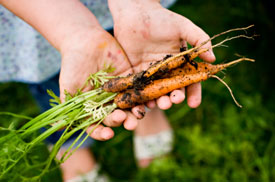
Many children’s songs and rhymes reference gardens and the vegetable world, but when I was a student we stayed indoors singing rather than experiencing that world firsthand. But in the last two decades, schools have introduced gardening into the curriculum as a way for students to learn lessons only nature can provide. Allowing students to research, design, and build a garden gives a teacher an opportunity to demonstrate the practical application of classroom subjects in a real world scenario.
Activities such as composting, selecting appropriate plants for a climate zone, and profiling soils are directly related to science and ecology. Building trellises, measuring wood for fences, and solving garden equations such as “If a row is 10 feet long and we plant our corn 12 inches apart how many corn stalks can we grow in one row?” all contribute towards mathematical problem solving. Having students keep a handwritten and illustrated journal is a great way for them to develop handwritingand written communication skills, and to scientifically observe and chronicle the seed-to-plant life cycle. The opportunities for learning go on and on, from collecting bugs and insects in a terrarium and observing their habitat and behavior, to researching the nutritional composition of vegetables grown, to learning safe kitchen procedures and following a recipe in preparation for cooking the harvest later in the school year.
When I was a child I detested most vegetables, even ones I had yet to taste! Because students are often willing to taste vegetables they have helped to grow, school gardens can improve a child’s eating habits, giving them nutrient rich foods that may be lacking in their diet. It’s also funfor children to participate in the preparation of meals, adding a sense of accomplishment in seeing their harvest from seed to plate. Students can opt to sell their vegetables and flowers to raise money for their school or a class field trip to a local garden. Introducing a business plan and how to handle money is a great hands-on math assignment that can be rewarding for students.
Just as important as the practical, hands-on skills that the garden teaches, are the aspects of self-regulation required to bring plants to maturity. A student who wishes to eat a carrot must leave the carrot in the ground until it is grown rather than pulling it up as soon as it sprouts. This lesson is quickly learned, as is the lesson that the carrot plant must receive proper care and nurturing in the form of sun and water and protection from frost and pests so it can fully develop. For many students, a garden provides a rare opportunity to experience first hand the importance of patience and nurturance as life skills. There are no short cuts, and pulling a big orange carrot out of the ground is an irrefutable reward for a job well done.
School gardens provide a highly practical and direct form of education, where children can see the results of their decisions and actions. Learning how to grow good food not only gives students a chance to apply classroom learning in a practical setting, but can also improve health, provide a livelihood, and increase self-sufficiency.
So find out how you can get involved in your school’s garden, or start to build one with your students. What a difference it can make.
Related Reading:
Modeling Healthy Choices: Three Habits for Optimal Brain Health
Individualizing Instruction Through Understanding Different Types of Learners

